Vidyard Alternatives
Looking for a Vidyard alternative? This guide compares 10 other platforms on features, pricing, and performance to inform your decision.

Vidyard is a popular choice for good reason. It excels at screen and video recording, and its analytics help track viewer engagement. For teams that need a straightforward way to create and share videos, it often gets the job done well.
However, some users find the editing tools limited or experience occasional glitches. If these issues affect your workflow, you may need an alternative. We've analyzed the top competitors to help you find the best fit for your team. Let's get started.
Consider 11x for Your Sales Team
For teams that use digital workers in their sales process, 11x is a relevant option. It adds autonomous agents to outreach and follow-up efforts. This approach can expand sales capacity without requiring a larger team.
As a GTM platform, 11x uses AI agents to manage the sales process. An agent named Alice finds prospects, handles outreach on email and LinkedIn, and updates the CRM. Julian, another agent, qualifies inbound leads and books appointments.
This approach combines data enrichment, outreach, and email warmup functions, so separate tools are not needed.
Vidyard Alternatives
This section breaks down the top Vidyard alternatives. We compare each tool's pricing, features, and key pros and cons to help inform your decision.
1) Loom

Loom is a video messaging platform to record a screen, camera, or both. Users share these videos to communicate with teammates and customers. The platform can replace long emails with quick video walkthroughs and offers an enterprise edition for secure, large-scale administration.
It is used by sales teams for outreach, engineers for code reviews, and customer support to troubleshoot issues.
Loom's Main Features
- AI-powered tools for automatic video enhancement and converting scripts into documents, messages, or bug reports.
- A video editor with functions for trimming, stitching clips, using custom backgrounds, and adding text or arrow overlays.
- Viewer engagement features including emojis, comments, tasks, calls-to-action, and automatic captions in over 50 languages.
- Enterprise-level security options such as SSO, SCIM, custom data-retention policies, and granular privacy controls.
How Loom Compares to Vidyard
Average Review score: 4.7/5 stars based on 2,119 G2 reviews.
- Loom provides AI tools that automatically convert video content into text for documents or bug reports. This offers a different kind of automation compared to Vidyard's focus on viewer engagement analytics.
- The platform includes an editing function that lets users modify the video by editing its text transcript. This provides a different editing experience from Vidyard's more traditional timeline-based editor.
- It integrates a screenshot tool for capturing, editing, and sharing static images. This adds a communication option for moments that do not require a full video, a function not native to Vidyard.
- An AI meeting assistant automatically records and summarizes live meetings into notes and action items. This feature positions Loom for both live and asynchronous communication, while Vidyard centers on asynchronous video.
Where Loom Differs From Vidyard
- Loom provides viewer insights, but it sometimes lacks advanced analytics like video heatmaps or detailed per-user viewing history. Vidyard includes these features, which are useful for in-depth sales analysis.
- It does not have native in-video lead capture forms. This is a feature Vidyard offers to help marketing teams gate content and send lead data directly to a CRM.
- The platform's options for creating a fully branded, public video hub are more limited. In contrast, Vidyard offers highly customizable video galleries that function as a central marketing content repository.
Pricing and Value Comparison
Loom offers a free starter plan, a business plan at $15 per user per month, and a business plan with AI for $20 per user per month. Vidyard also provides a free plan, but its paid tiers start at $25 per user per month, making Loom a more affordable option for smaller teams.
2) Wistia
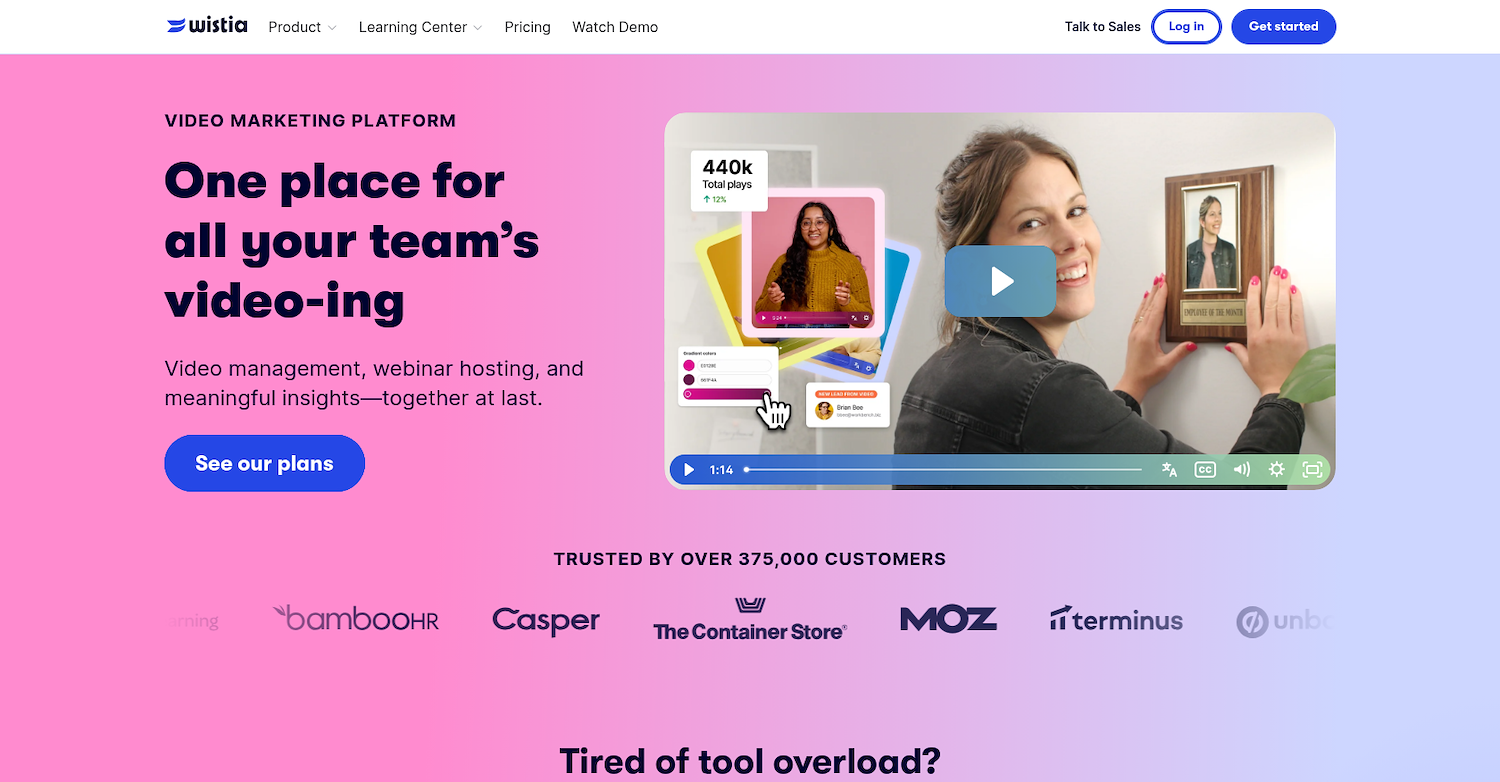
Wistia is a video marketing platform with tools to host, create, and analyze content. Teams can record tutorials or sales videos from a laptop, then edit and publish them. The platform also delivers webinars and generates leads with in-player forms.
It integrates with marketing automation software to connect video data to lead nurture workflows. The system combines multiple video functions into a single place for marketing and sales teams.
Wistia's Main Features
- The platform hosts live or pre-recorded webinars with custom branding and automatically repurposes recordings for evergreen content.
- It includes built-in video SEO features to improve content discoverability in search results.
- An ad-free, customizable player supports localization in over 30 languages.
- A dedicated API allows for the creation of custom video experiences.
How Wistia Compares to Vidyard
Average Review score: 4.6/5 stars based on 813 G2 reviews.
- Wistia includes a native webinar feature for live or pre-recorded events. This provides a different function compared to Vidyard, which focuses on asynchronous video messages.
- The platform offers built-in video SEO tools to help content rank in search results, a specific marketing feature not highlighted in Vidyard's core offering.
- It allows for one-click video replacement, which updates a video everywhere it is embedded without changing the link. This simplifies content updates compared to Vidyard's standard process.
- This tool provides more granular control over the video player, such as the option to disable the playbar. Vidyard offers gallery customization but with less focus on individual player behavior.
Where Wistia Differs From Vidyard
- Wistia's analytics sometimes lack the depth found in Vidyard. For instance, it may not provide detailed per-user viewing history or video heatmaps, which are useful for in-depth sales analysis.
- The platform offers fewer options for creating a fully branded, public video hub. Vidyard provides more extensive customization for its video galleries, which can act as a central marketing repository.
- Some users report that managing user permissions can be less straightforward than in Vidyard. This might create challenges for larger teams that need specific access levels for different roles.
- Its webinars have a 720p resolution limit. This can be a factor for teams that require high-definition quality for product demos or detailed visual presentations.
Pricing and Value Comparison
Both tools offer free plans. Wistia’s paid tiers begin at $19 per month, while Vidyard’s start at $25 per user per month, making Wistia a more accessible entry point. For detailed tier comparisons, see Wistia's official website.
3) Brightcove
Brightcove is an enterprise video platform used to broadcast and publish content at scale. It serves large organizations with needs in marketing, internal communications, and monetization. The system is built for high-volume video delivery and management.
Brightcove's Main Features
- Video monetization tools, including server-side ad insertion and subscription support.
- Enterprise-grade live stream functions for large-scale virtual events and broadcasts.
- A video content management system designed for extensive media libraries.
- Advanced security features that meet enterprise compliance and data protection standards.
How Brightcove Compares to Vidyard
Average Review score: 4.2/5 stars based on 418 G2 reviews.
- Brightcove provides monetization options, such as server-side ad insertion. This is a core feature for media companies and is outside Vidyard’s focus on sales and marketing videos.
- The platform is built for large-scale live events. This allows for broadcasts to global audiences, a different use case than Vidyard’s asynchronous messages.
- It offers over-the-top (OTT) video solutions to create branded streaming services. This capability serves media publishers, a market distinct from Vidyard’s corporate users.
- Its analytics are designed for broadcast-level insights, with a focus on audience reach and ad performance. Vidyard’s analytics track individual viewer engagement for sales qualification.
Where Brightcove Differs From Vidyard
- Brightcove’s pricing is often complex and quote-based, which can be a significant investment. This contrasts with Vidyard's transparent, per-user pricing models.
- The platform can have a steeper learning curve and may require technical staff for implementation. Vidyard is generally designed for easier adoption by non-technical business users.
- It does not include simple screen recording or one-to-one video message tools. Its focus is on large-scale content distribution, not personal outreach.
- Integrations are geared toward enterprise systems and ad tech. This differs from Vidyard’s native connections with common sales and marketing automation platforms.
Pricing and Value Comparison
Brightcove does not offer public pricing plans; costs are customized based on usage and features. This model is typical for enterprise solutions and differs from Vidyard’s tiered, per-user pricing. It is best suited for large companies with specific broadcast or monetization requirements.

Brightcove provides a video platform for large-scale distribution, analysis, and monetization. Its products include studios for marketing, communications, and media, plus an AI content suite. The system is for enterprise marketers, media companies, and internal communications teams.
Use cases cover corporate communications, live events, and OTT channels. The platform helps organizations manage video content, with some reports that show a reduction in time on content tasks.
Brightcove's Main Features
- Offers video monetization tools, including an ad monetization service and subscription support.
- Provides enterprise-grade live stream functions for large-scale virtual events and broadcasts.
- Includes a video content management system designed for extensive media libraries.
- Features advanced security options such as DRM, encryption, and access control to meet enterprise compliance standards.
How Brightcove Compares to Vidyard
Average Review score: 4.0/5 stars based on 53 G2 reviews.
- Brightcove includes video monetization tools like ad insertion and subscriptions to serve media publishers. In comparison, Vidyard does not offer these tools and focuses on lead generation for sales teams.
- It offers enterprise-grade live stream functions for large-scale virtual events. This capability allows broadcasts to global audiences, a different use case from Vidyard's tools for asynchronous video messages.
- The platform provides advanced security features, including Digital Rights Management (DRM) and ISO/IEC 27001:2022 certification. These options meet enterprise compliance needs that are more extensive than Vidyard's standard security protocols.
- This tool's analytics focus on broadcast-level insights such as audience reach and ad performance. This approach differs from Vidyard's analytics, which track individual viewer engagement to qualify sales leads.
Where Brightcove Differs From Vidyard
- Brightcove's analytics sometimes lack the depth needed for sales. For example, it does not provide detailed per-user viewing history or video heatmaps, which Vidyard includes for in-depth lead analysis.
- The platform does not offer native in-video lead capture forms. This is a function Vidyard provides to help marketing teams gate content and send lead data directly to a CRM.
- Its options for creating a fully branded, public video hub are sometimes less flexible for marketing teams. Vidyard, in comparison, offers highly customizable galleries that serve as a central content repository.
Pricing and Value Comparison
While we've covered key features and use cases in this comparison, pricing models can vary significantly between tools. For the most accurate and up-to-date pricing information, we recommend visiting Brightcove's official website.
4) Vimeo
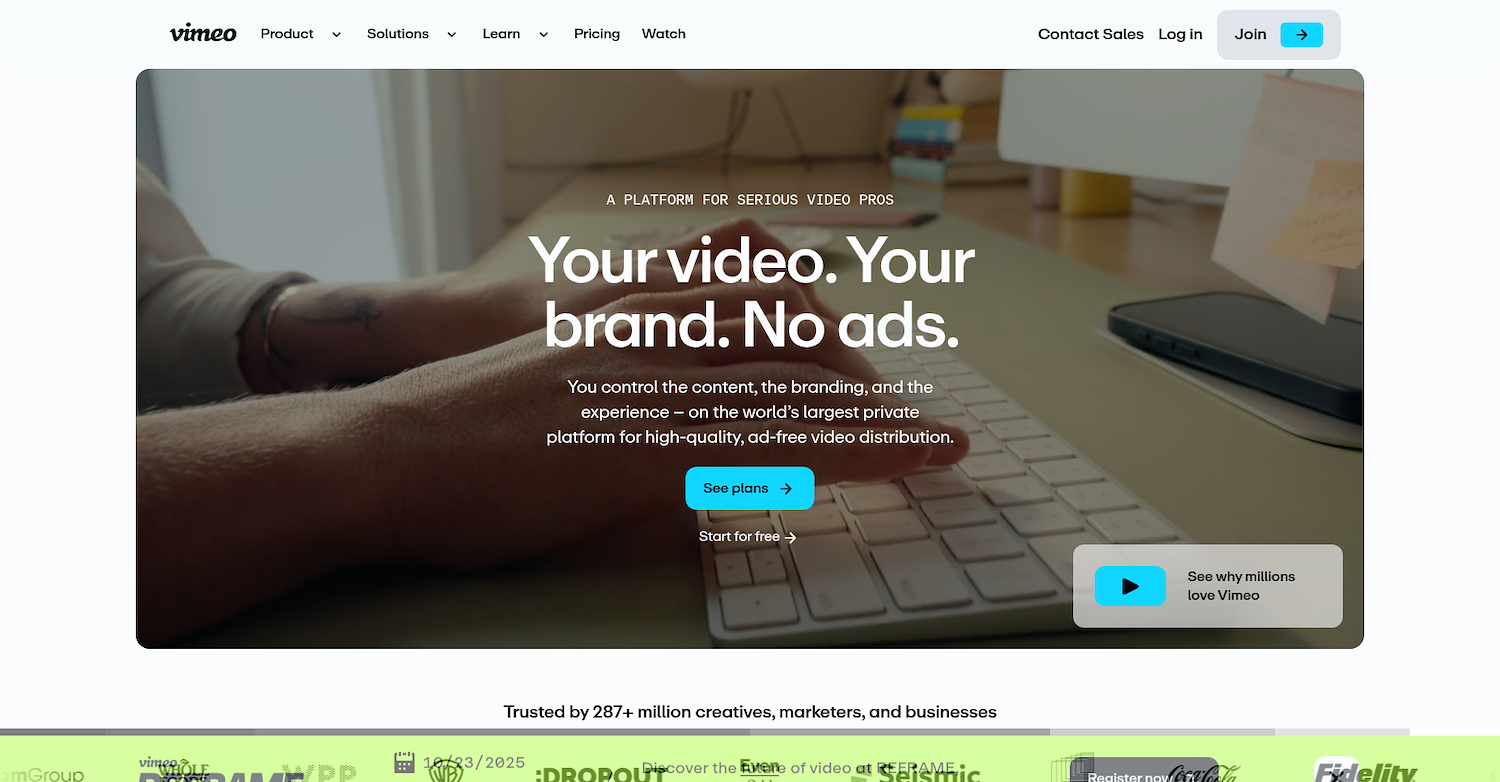
Vimeo offers a video platform with tools to create, manage, and share content. Users can record their screen and camera, edit videos, and host live events. It serves teams in corporate communications, marketing, and human resources. The system acts as a central library for all of an organization's video assets.
Vimeo's Main Features
- It offers monetization tools for on-demand sales and subscriptions, including support for creating an over-the-top (OTT) streaming service.
- The platform includes a live streaming suite for hosting virtual events, webinars, and large-scale broadcasts through Vimeo Venues.
- AI tools provide text-based video editing and an in-player Q&A function that links answers to specific moments in the video.
- It provides enterprise-level security with features like a HIPAA-compliant solution, SOC 2 Type II certification, and AES-256 encryption.
How Vimeo Compares to Vidyard
Average Review score: 4.3/5 stars based on 695 G2 reviews.
- Vimeo offers monetization tools for on-demand sales and subscriptions. This differs from Vidyard, which focuses on lead generation rather than direct video revenue.
- The platform includes a live streaming suite for hosting large virtual events and webinars. Vidyard, in comparison, is designed for asynchronous video messages.
- Its AI tools let users edit a video by modifying its text transcript. This provides a different editing experience from Vidyard's more traditional timeline-based editor.
- This tool provides access to a stock footage library to enhance videos. Vidyard does not include a similar built-in library, so users must source their own external clips.
Where Vimeo Differs From Vidyard
- Vimeo's analytics sometimes lack the depth for sales teams. For example, it does not provide detailed per-user viewing history or video heatmaps, which Vidyard includes for in-depth lead analysis.
- The platform does not offer native in-video lead capture forms. This is a function Vidyard provides to help marketing teams gate content and send lead data directly to a CRM.
- Its options for creating a fully branded, public video hub are sometimes less flexible for marketing teams. Vidyard, in comparison, offers highly customizable galleries that serve as a central content repository.
Pricing and Value Comparison
Both platforms offer free plans. Vimeo’s paid plans start at $20 per month, while Vidyard’s begin at $25 per user per month, making Vimeo a slightly more affordable entry point. For more advanced features, Vimeo offers Standard and Advanced plans at $33 and $108 per month, respectively.
5) BombBomb
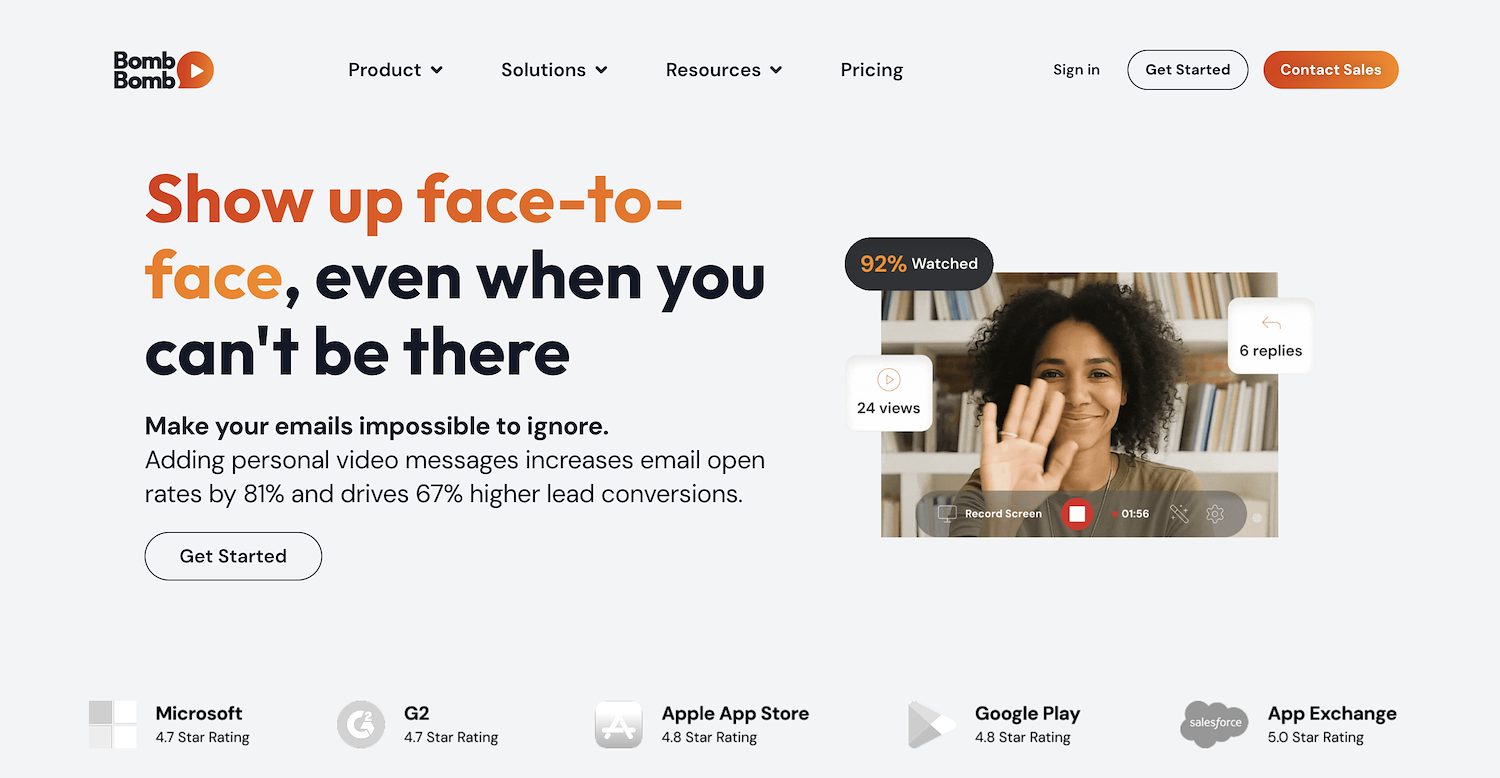
BombBomb is a video messaging platform for sales professionals. Users record and send personal videos from a desktop or mobile device. The system integrates with email clients and CRMs to place video inside existing workflows.
Sales teams use it for outreach, lead follow-up, and customer communication. The goal is to add a human element to digital messages and build relationships through video.
BombBomb's Main Features
- The platform provides automated outreach campaigns with smart assignment and fallback logic.
- A single dashboard tracks views, engagement, and team performance metrics.
- Users organize videos with labels, permissions, and team workspaces for content management.
- Mobile apps for iOS and Android allow users to record and send videos from their devices.
How BombBomb Compares to Vidyard
Average Review score: 4.7/5 stars based on 583 G2 reviews.
- BombBomb provides automated outreach campaigns with smart assignment logic. This feature offers a more structured system for video prospecting compared to Vidyard's focus on individual video analytics.
- Its mobile application allows users to quickly record and send videos from a phone. This approach is more direct for on-the-go sales communication than Vidyard's app, which also includes library management functions.
- The platform gives real-time notifications when a recipient opens an email or plays a video. This immediate feedback is more granular for individual outreach than Vidyard's broader engagement reports.
- This tool integrates directly into email clients like Gmail and Outlook, so users can record and add videos without leaving their inbox. This workflow is more self-contained than Vidyard's, which typically requires a separate browser extension window.
Where BombBomb Differs From Vidyard
- BombBomb's analytics sometimes lack the depth for sales analysis. For example, it does not provide video heatmaps or detailed per-user viewing history, features that Vidyard includes for in-depth lead qualification.
- The platform does not have native in-video lead capture forms. This is a feature Vidyard offers to help marketing teams gate content and send lead data directly to a CRM.
- It offers fewer options for creating a fully branded, public video hub. In contrast, Vidyard provides highly customizable video galleries that can function as a central marketing content repository.
Pricing and Value Comparison
BombBomb’s pricing is not publicly listed, which differs from Vidyard’s transparent tiers that start at $25 per user per month. For the most accurate and up-to-date pricing information, we recommend visiting BombBomb's official website.
Add Digital Workers with 11x
If your sales team uses digital workers, consider 11x. The platform adds autonomous agents to handle outreach and follow-up tasks. This approach can expand sales capacity without a larger team.
With 11x, we use AI to run your sales playbook. Our agent Alice finds accounts, enriches their data, and handles outreach, while Julian qualifies prospects and schedules meetings. Our platform consolidates tools for intent signals and email warmup, replacing other parts of the GTM stack.
Book a demo to see it in action.
6) Screencastify
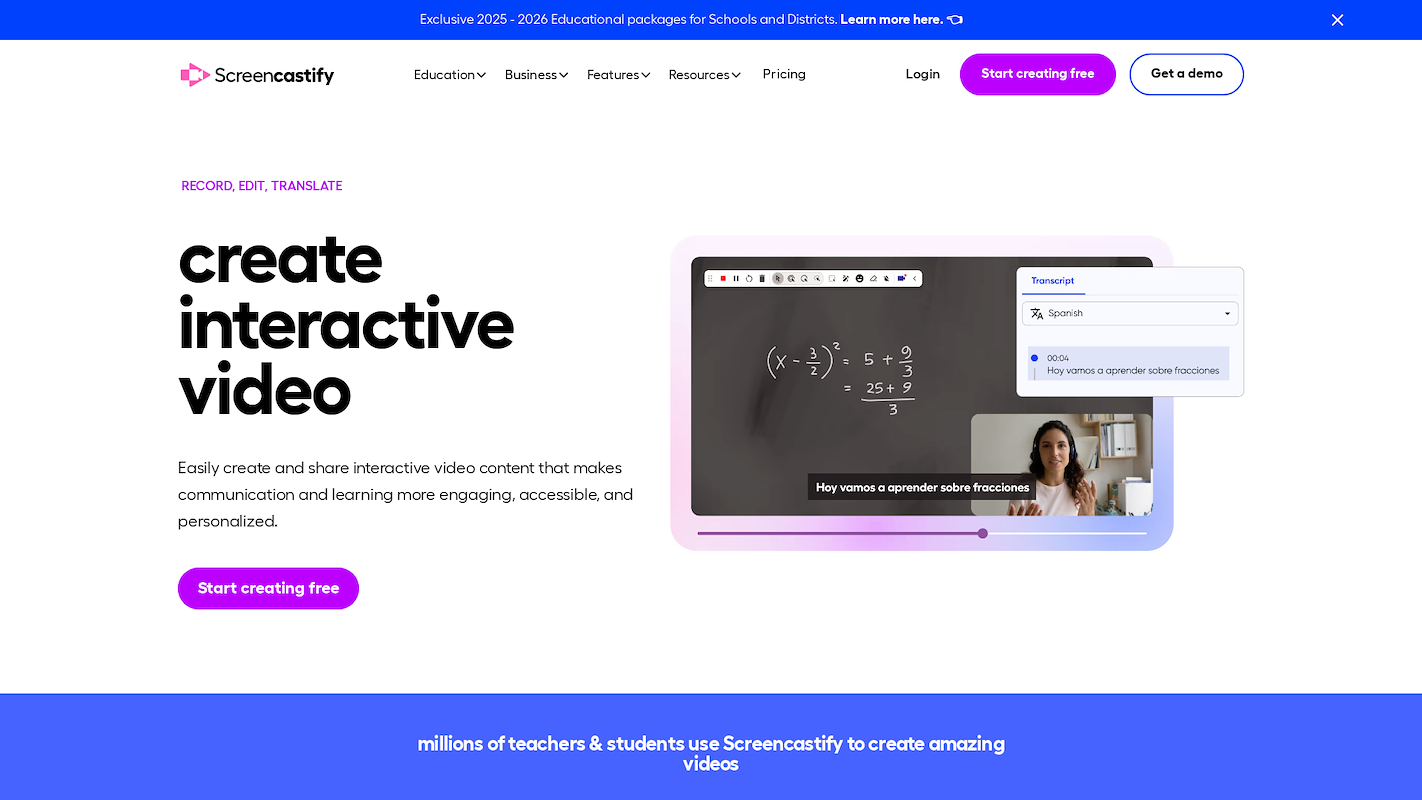
Screencastify is a tool to record screen and video content. It allows users to capture their screen, webcam, or both at the same time. The platform operates as a browser extension for quick access to its capture functions.
It sees use in education for lesson development and in business for employee instruction or customer support walkthroughs.
Screencastify's Main Features
- Adds auto-graded interactive questions to any video.
- Collects video assignments from viewers through a "Submit" feature.
- Offers AI-powered caption translation into more than 50 languages.
- Includes a video editor with functions to trim, merge, zoom, and add text.
How Screencastify Compares to Vidyard
Average Review score: 4.6/5 stars based on 70 G2 reviews.
- Screencastify adds interactive, auto-graded questions to videos. This feature offers a different way to engage viewers compared to Vidyard's focus on calls-to-action for lead capture.
- The platform includes a "Submit" feature that lets viewers send video assignments. This function supports training and educational use cases, which are outside Vidyard's primary sales and marketing scope.
- It operates mainly as a lightweight browser extension for quick recording. This offers a more direct workflow for users inside Chrome, while Vidyard's extension often opens a separate platform interface.
- This tool automatically saves recordings to Google Drive. This integration provides a different storage option for teams that use Google Workspace, unlike Vidyard, which uses its own hosting system.
Where Screencastify Differs From Vidyard
- Screencastify's analytics sometimes lack the depth needed for sales analysis. It does not provide video heatmaps or detailed per-user viewing history, which Vidyard includes for in-depth lead qualification.
- The platform does not have native in-video lead capture forms. This is a feature Vidyard offers to help marketing teams gate content and send lead data directly to a CRM.
- It offers fewer options for creating a fully branded, public video hub. In contrast, Vidyard provides highly customizable video galleries that can function as a central marketing content repository.
Pricing and Value Comparison
While we've covered key features and use cases in this comparison, pricing models can vary significantly between tools. For the most accurate and up-to-date pricing information, we recommend visiting Screencastify's official website.
7) Hippo Video
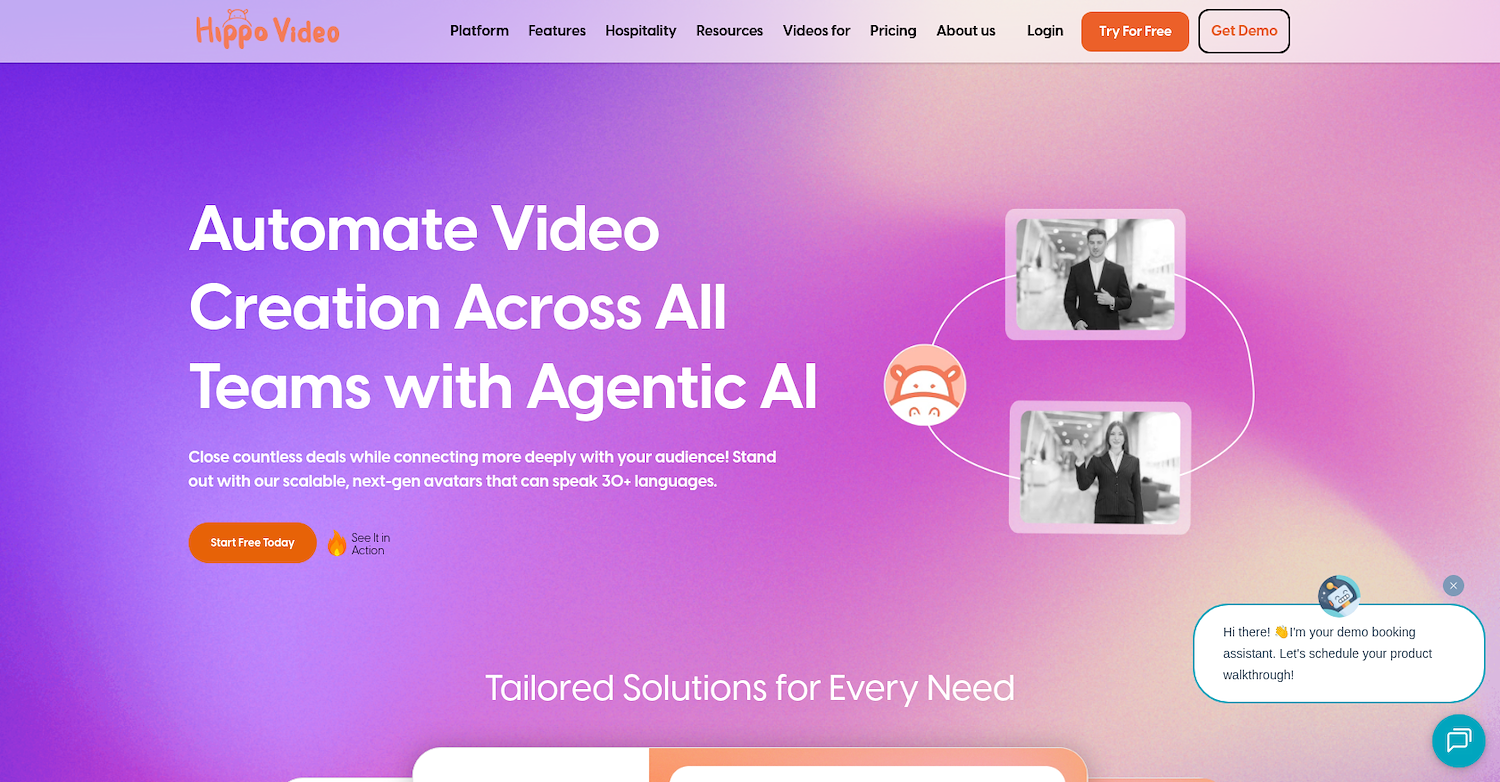
Hippo Video is a video platform for business communication. It provides tools for sales, marketing, and support teams to create and share personalized videos. Common uses include prospect outreach, campaign distribution, and customer support responses. The system also tracks viewer engagement to measure video performance.
Hippo Video's Main Features
- Converts text, PPTs, or PDFs into videos with AI avatars using an "Agentic AI" creation tool.
- Creates a "Digital Twin" AI avatar that mirrors a user's voice and gestures for use in demos and support.
- Provides a video chatbot that functions as an always-on, real-time video assistant for websites.
- Includes an SDK and API to embed video creation, editing, and playback functions into other applications.
How Hippo Video Compares to Vidyard
Average Review score: 4.5/5 stars based on 734 G2 reviews.
- Hippo Video creates videos from text or documents using AI avatars. This differs from Vidyard, which requires users to record their screen or camera.
- It offers a "Digital Twin" AI avatar that mirrors a user's voice and gestures. This provides a scalable way to create demos, unlike Vidyard's focus on personal recordings.
- The platform includes a video chatbot for websites to assist visitors in real time. This is a different approach from Vidyard's asynchronous video messages.
- This tool provides an SDK and API to embed video creation and editing functions into other applications, allowing for deeper custom integrations.
Where Hippo Video Differs From Vidyard
- Some users report that Hippo Video's analytics are less detailed for sales purposes compared to Vidyard. The platform does not include video heatmaps or specific per-user viewing history, which can be useful to score leads.
- It does not offer native lead capture forms inside the video player itself. Vidyard includes this feature, which allows marketing teams to gate content and send lead information directly to a CRM.
- The tool's options to create a fully branded public video hub are sometimes less flexible. In comparison, Vidyard provides more extensive customization for its video galleries, which can serve as a central content hub for marketing teams.
Pricing and Value Comparison
Both tools offer a free plan. Hippo Video’s Pro plan starts at $20, offering a lower entry point than Vidyard’s paid plans, which begin at $25 per user per month. Hippo Video also has team and enterprise plans at $60 and $80.
8) CloudApp
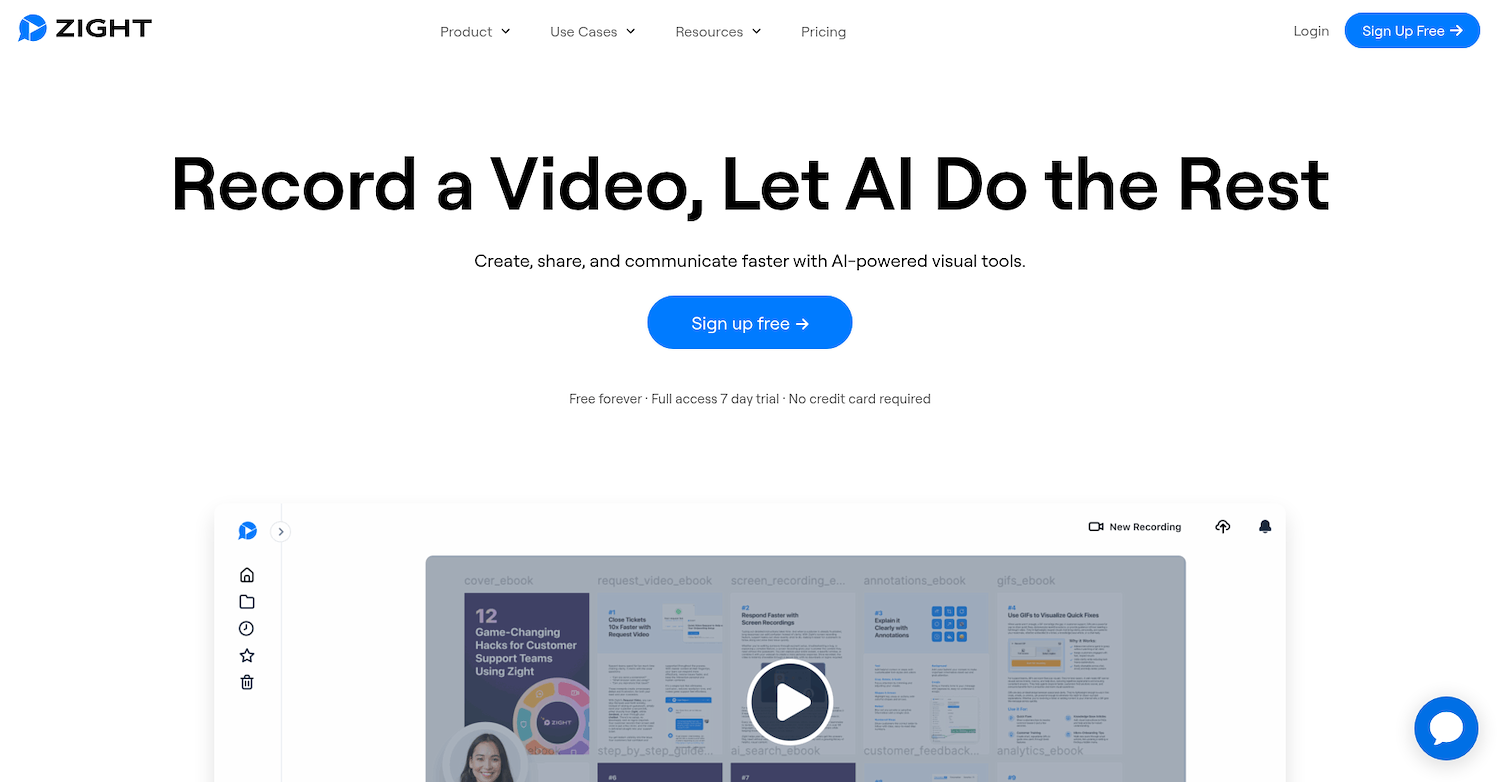
CloudApp is a platform for visual communication. Users capture their screen with video, GIFs, and screenshots. Annotations can be added, and content is shared with a link.
Sales, support, and engineering teams use it for tasks like bug reports, product demos, and customer updates. The goal is to substitute long text with quick visual explanations.
CloudApp's Main Features
- Includes gamification features with custom and team-based competition templates.
- Uses a deep-learning AI engine to create deal predictions and sales forecasts from CRM data.
- Provides reporting and user management tools for pipeline visibility and access control.
- Integrates with Salesforce as an AppExchange Partner and connects with social collaboration platforms.
How CloudApp Compares to Vidyard
Average Review score: 4.5/5 stars based on 23 G2 reviews.
- CloudApp includes gamification features, such as competition templates, to motivate sales teams. This offers a different approach to team engagement compared to Vidyard, which focuses on individual video performance analytics.
- It uses a deep-learning AI to create deal predictions and sales forecasts directly from CRM data. This provides predictive insights, whereas Vidyard's analytics track past viewer engagement.
- The tool offers deep Salesforce integration as an AppExchange Partner to analyze CRM data, even if it is incomplete. Vidyard also connects with CRMs but mainly to pass lead data from videos.
- This platform consolidates information from various business tools to give actionable insights on each deal. This differs from Vidyard, which generates insights based only on video viewer behavior.
Where CloudApp Differs From Vidyard
- CloudApp's analytics focus on sales forecasts from CRM data. This differs from Vidyard, which offers video heatmaps that show which parts of a video a prospect watches most, providing specific engagement insights.
- The platform does not include native in-video lead capture forms. Vidyard provides this feature to help marketing teams gate content and send lead data directly to a CRM.
- It offers fewer options for creating a fully branded, public video hub. In contrast, Vidyard provides highly customizable video galleries that can function as a central marketing content repository.
Pricing and Value Comparison
CloudApp's pricing starts at £60 for 50 users per year, a different model from Vidyard's plans, which start at $25 per user per month. This structure may offer a lower cost per user for large teams, but Vidyard's model provides more flexibility for smaller groups.
9) StoryXpress
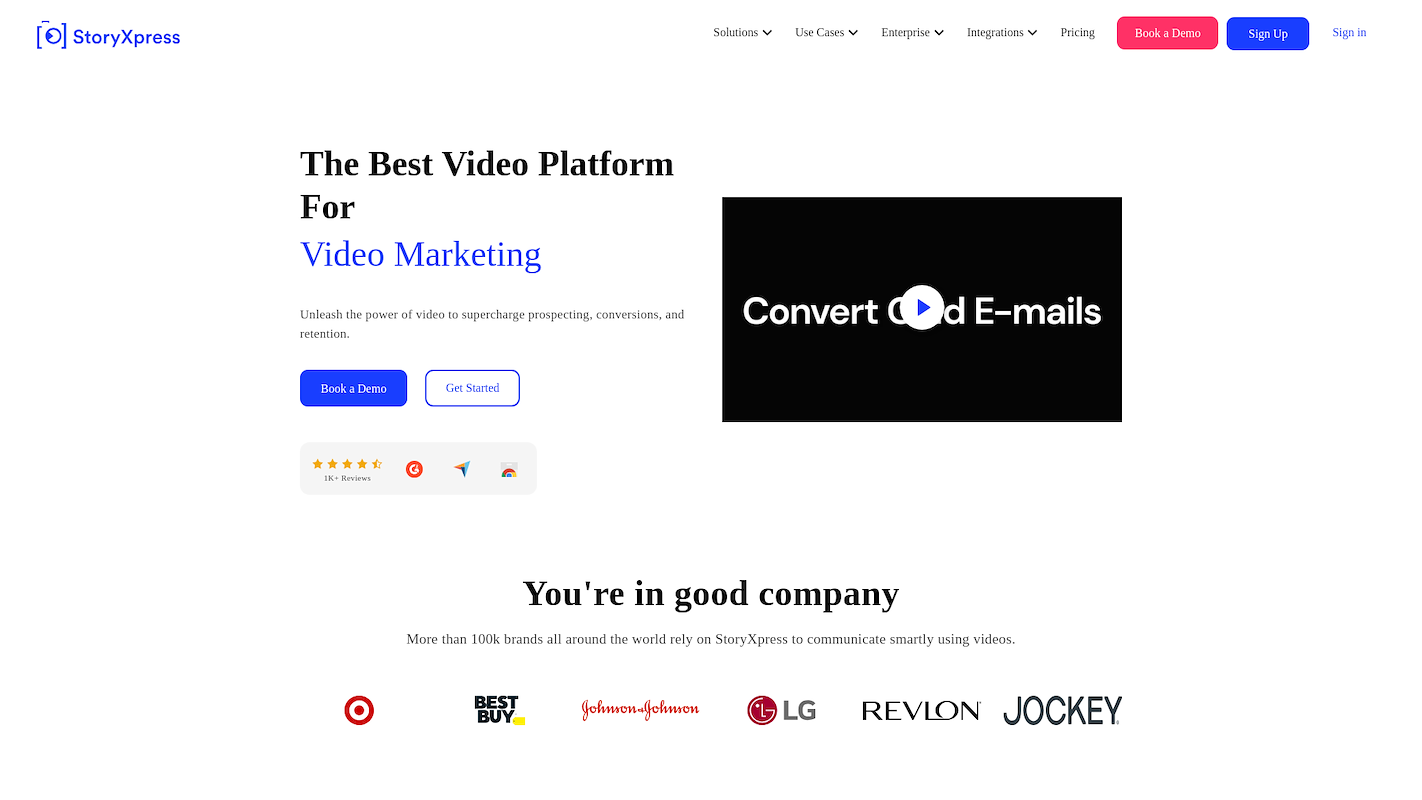
StoryXpress is a video platform that enables teams to record, edit, and share content. Sales and marketing professionals use it to create product demos, tutorials, and personalized outreach. The system provides a central library for video assets and includes analytics to measure viewer engagement.
StoryXpress's Main Features
- It provides viewer analytics, including heatmaps, and allows for the addition of calls-to-action within videos.
- The platform offers customizable players and branded video pages for sharing content.
- It generates animated GIF previews for embedding videos directly into emails.
- The tool integrates with MailChimp, Calendly, and Zapier, and provides API access for custom connections.
How StoryXpress Compares to Vidyard
Average Review score: 4.9/5 stars based on 25 G2 reviews.
- StoryXpress generates animated GIF previews for emails. This feature can improve click-through rates compared to the static thumbnails common with Vidyard.
- The platform includes annotation tools to add notes directly onto videos. This provides more editing options compared to Vidyard's more basic editing functions.
- It integrates directly with tools like MailChimp and Calendly. This differs from Vidyard, which often focuses on larger enterprise systems like CRMs.
- Users report that its customer support is highly responsive. This is an advantage for teams that need quick technical assistance.
Where StoryXpress Differs From Vidyard
- Some users report that the platform's options for organizing large video libraries are limited. This can make asset management difficult for teams with extensive content, unlike Vidyard's more structured system.
- It does not have a built-in function to add lead capture forms inside the video player. Vidyard includes this feature, which lets marketing teams collect viewer information directly from the video.
- The tool's options to create a fully branded public video hub are sometimes less flexible. Vidyard provides more advanced customization for its video galleries, which act as a central marketing content repository.
Pricing and Value Comparison
StoryXpress offers a Lite plan starting at $10 per month, providing a lower entry point than Vidyard's paid plans, which begin at $25 per user per month. This makes StoryXpress a more budget-friendly option for basic needs. StoryXpress also offers Pro and Plus plans at $49 and $199 per month, respectively.
10) Dubb
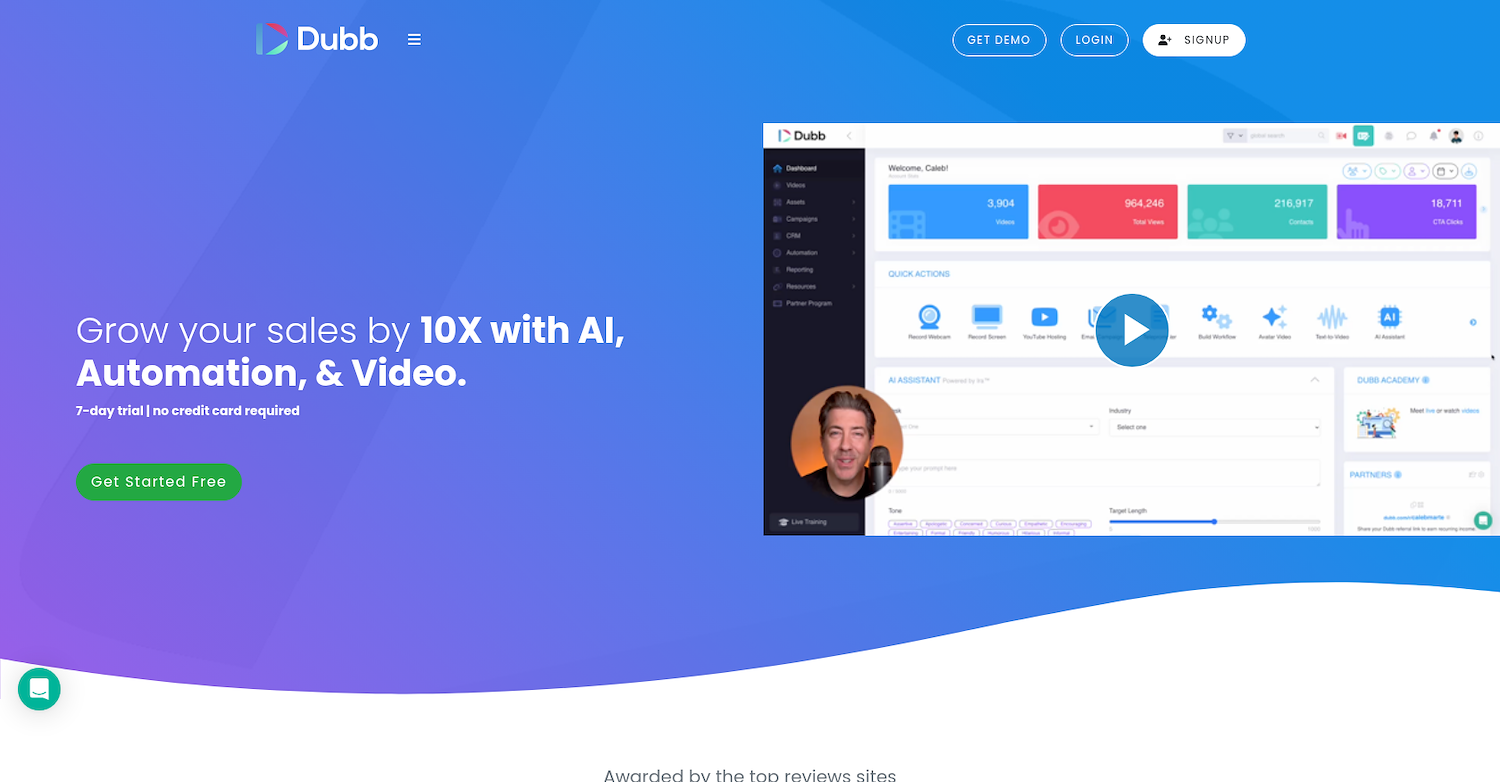
Dubb is a video communication platform with tools to record screen and video content. As a Vidyard alternative, it supports business teams in sales, marketing, and customer communication.
Dubb's Main Features
- Provides tools for content creation, video management, and hosting with a dedicated player.
- Tracks campaign performance and individual recipient activity.
- Generates analytics and reports to measure video engagement.
How Dubb Compares To Vidyard
Average Review score: 4.6/5 stars based on 555 G2 reviews.
- Dubb includes CRM functionalities, which combines video messaging and customer relationship management in one platform. This differs from Vidyard, which integrates with external CRMs.
- The platform offers marketing automation features. This allows users to build video-based campaigns directly within Dubb, a function that often requires a separate tool when using Vidyard.
- It provides campaign performance tracking tied to its internal CRM. This creates a unified view of how video impacts the sales cycle, whereas Vidyard sends data to an external system.
- Users often note the responsive customer support. This provides a reliable resource for teams that need quick help, an aspect that can vary with platforms like Vidyard.
Where Dubb Differs From Vidyard
- Some users find that Dubb's analytics are less detailed for sales purposes. The platform does not offer video heatmaps, a feature Vidyard provides to show which parts of a video a prospect watched most.
- It does not include a native tool for in-video lead capture forms. This is a function Vidyard offers to help marketing teams gate content and send lead data directly to a CRM.
- This tool offers fewer options to create a fully branded, public video hub. In contrast, Vidyard provides highly customizable video galleries that can function as a central marketing content repository.
Pricing and Value Comparison
Dubb offers a Pro plan at $59 per month, while Vidyard's paid plans begin at $25 per user per month. Vidyard is more cost-effective for individuals, but Dubb's flat rate makes it a more economical choice for teams of three or more.
Which One Should You Go With?
Choosing a Vidyard alternative involves many variables, including team needs and budget. This guide shared several options to help you decide on the right platform for your specific use case.
If your sales process uses digital workers, 11x is a relevant option. The platform adds autonomous agents to handle outreach and follow-up, which can expand sales capacity without requiring a larger team.




